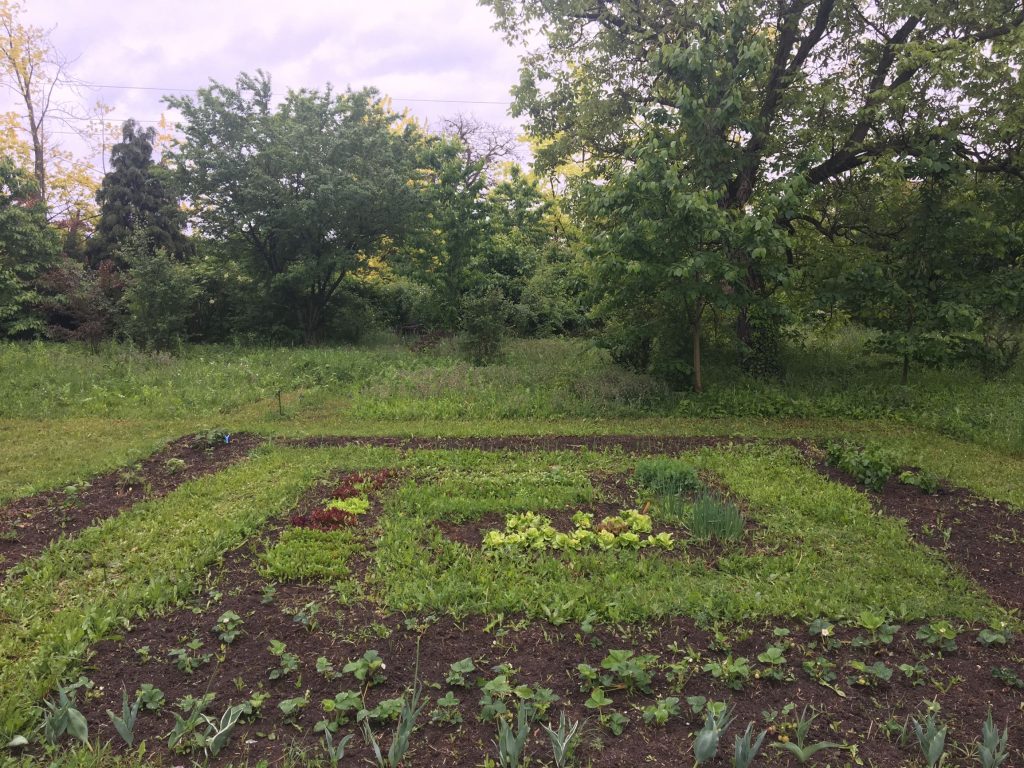In the spring of 2018, at ESSRG we collected research needs related to green care services (therapeutic approaches which integrate the power of nature). Reviewing the claims, we perceived that the key players of this field had lacked the impact evaluation researches that would have verified the effectiveness of these services and the healing power of nature.
In June 2018, a vice headmaster of Szentendrei Móricz Zsigmond Grammar School in Szentendre (a town near Budapest) invited us to set up a school garden inside the school courtyard. This fieldwork enabled us to address the impact evaluation-related concerns mentioned earlier and to conduct assessing experiments throughout a whole school year in order to give responses to the following questions: What happened to a first-year Mathematics, Physics oriented class (aged between 14-15 years) who participated in establishing a school garden? How did their relationships with each other and with nature changed during this journey?
But let’s start at the beginning!
Creating something totally new together with first-year students who had just started their high school student “careers” was a real co-learning process. We gradually got to know each other, the head teacher, the headmaster, those teachers who were keen to join the school garden project and the piece of land we filled with new meaning and energies.
At our first visit, we asked the students to make joy-sorrow maps of the courtyard in order to identify the coolest and the least cool parts of the yard. We were brave enough to choose one of the most problematic areas to work with. The students described this part as weedy, chaotic but at the same time calm and quiet as it was far from the noisy school buildings.

At our second meeting, students planned their dream school gardens in small groups. They created four plans by making a montage of pictures and drawings for which the whole class could vote for an entire week.
And the winner was:

Everybody was impressed with the unique spiral shape in which they planted the flowers, herbs, vegetables and berry bushes.
Based on this montage of the dream garden, we created a garden plan down to earth, which meant that we selected suitable plant species and paired them according to their general requirements. Then, with the leadership of the committed and enthusiastic head teacher, the students started to dig, get rid of the tons of weed, plant and water in parallel with the scientific work in the frame of Biology and Chemistry lessons to examine the quality of the soil and those plants which could be identified near the garden.

And the spiral shape was born:

In parallel with this co-creation process, at ESSRG we compiled our own plan regarding the evaluation research. We planned to apply six different approaches in order to assess the changes in the students’ relationships with nature and with their classmates: 1.) observations during the planning and implementing phases, 2.) interviews with the head teacher and other attending teachers, 3.) measuring the changes of the students’ environmental attitude with the Children’s Environmental Attitude and Knowledge Scale (CHEAKS) and the New Ecological Paradigm Scale (NEP), 4.) online questionnaires with the parents, 5.) photovoice participatory evaluation, and lastly 6.) facilitated group discussions.
Luckily, in the same time when we started the gardening project, we also run an Ecological Economics field course at Eötvös Loránd University engaging Human Ecology master students. This allowed us to merge the school gardening project with university teaching for the autumn semester and involve the students in the impact assessment process. As part of the course we first offered an introductory block, then students had to create and implement their own research plan in small groups (3 or 4 students in one group), choosing their method from a predefined list. Supervision, technical and methodological support, and several occasions for personal reflection were provided all along the process by the two course organizers.
One group of university students chose environmental attitude survey as their approach to impact assessment. The class working in the garden and a control group of Literature, Grammar, History focused students at the same age had filled in the attitude questionnaires before they started to involve deeply in the gardening program. The other group of university students facilitated a photovoice research process: those students who attended the gardening media team took photos during the garden preparation sessions and talked about them in a group discussion as the first step of the photovoice project.
After the semester had finished, we carried on the impact assessment research. For us one of the most memorable group discussions was when the students compiled the guidebook of the school garden for the future garden owners. (The plan was that from now on the first-year Mathematics, Physics oriented class would be responsible for the garden.)
They expressed that the garden had played really important role in their life. During gardening sessions, they had a chance
to make new friends, to have fun,

to experience how to work as a team, to learn practical things and to spend time in nature after a long, tiring day. We perceived that the students established collaborative relationships with each other as the borders of cliques are getting blurred when they were in the garden. Their relationship with nature became more tangible and more articulated as they spent more time in contact with it: “During gardening, I recall plenty of good childhood memories.”
“The garden is a sensitive being. Take care of it.” “If you nurture it properly, it will provide more delicious vegetables.”

Besides, they felt that they left a mark on the school life with this garden.

They did it indeed.
Since September 2019 two classes have been taking care of the school garden allowing us to repeat our environmental attitude survey and to follow up how the garden changes the school life… ?
Photos by Alexandra, Hanna, Simon, Vince, Rita Szentendrey, Eszter Kelemen, Janka Horváth
The school garden project was funded by the InSPIRES project.
